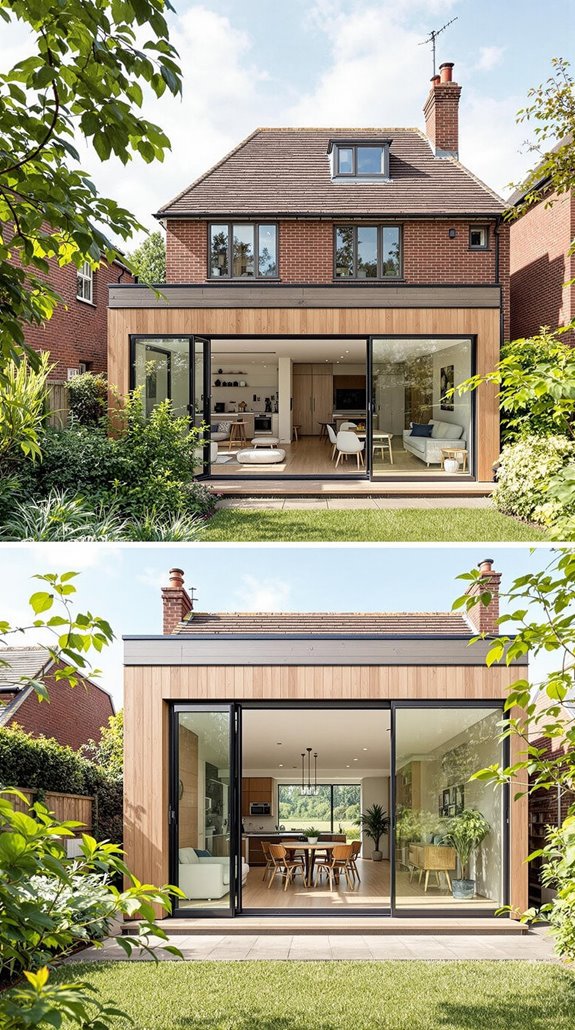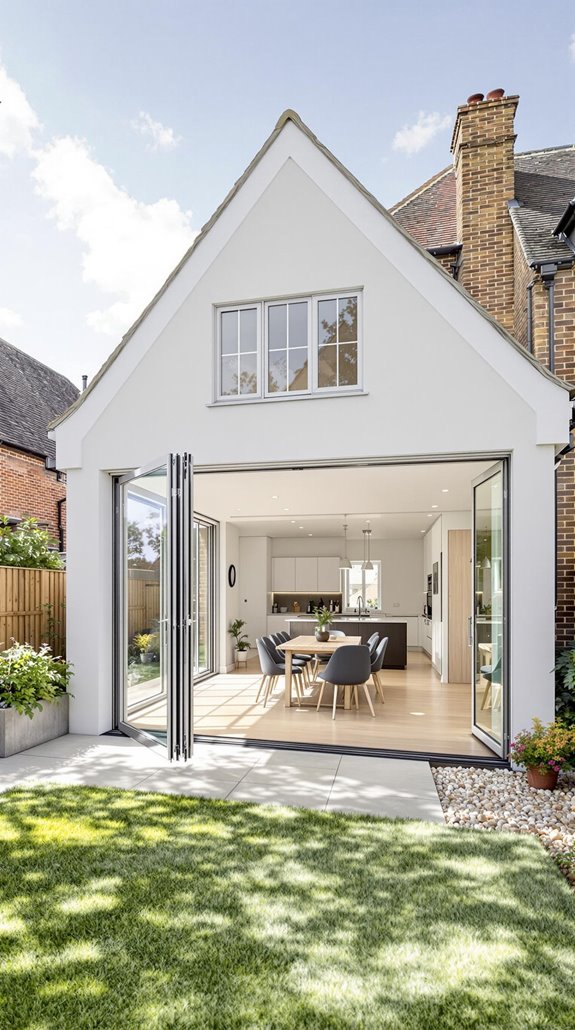I’ve helped dozens of homeowners transform their properties with rear extensions, and I can tell you that the right approach makes all the difference between a costly mistake and a strategic investment. The key lies in understanding how regional costs, extension types, and sizing decisions directly impact your budget and property value. Before you commit to any design, there’s a critical framework I use to evaluate whether your extension will deliver the returns you’re expecting.
Key Takeaways
- Single-storey rear extensions cost £25,000–£40,000, add 15–30m² of space, and increase property value by 5–8%.
- Double-storey rear extensions cost £120,000–£200,000, create 30–50m² across two levels, and deliver up to 11% value increases.
- Kitchen extensions through rear additions yield 6–10% property value uplift with strong return on investment potential.
- Compact extensions under 20m² often qualify for permitted development, avoiding planning permission if height and boundary rules are followed.
- Regional costs vary significantly: London rates £1,500–£2,000/m² versus Midlands/Northern England at £1,200–£1,500/m².
Regional Cost Variations Across the UK for Rear Extensions

When planning a rear extension, understanding regional cost variations across the UK becomes essential for accurate budgeting and project feasibility. I’ve analyzed the data to help you navigate these differences effectively.
London commands the highest prices, with single-storey extensions averaging £83,258–£103,834 and double-storey projects reaching £138,434–£173,574. The South East follows closely with similar premium rates.
Northern England offers the most affordable options, with single-storey extensions costing £74,934–£88,558 and double-storey projects at £124,191–£146,771. The Midlands and East Anglia fall between these extremes, with single-storey costs around £76,740–£93,443.
Scotland and Northern Ireland present mid-range pricing, while Wales typically aligns with similar regional patterns. These variations reflect local labor costs, material availability, and market demand across different areas. Properties in these regions can expect 10-20% increases in value when extensions are completed successfully.
Single-Storey Vs Double-Storey Extension Investment Comparison
Single-storey extensions cost £25,000–£40,000 and boost property value by 5–8%. They’re completed in 12 weeks, often qualify for permitted development, and create 15–30m² of functional space, making them a popular choice for homeowners looking to maximize their investment. Double-storey extensions require £120,000–£200,000 but deliver up to 11% value increases, adding 30–50m² across two levels.
Your choice depends on budget, timeline, and goals. If you’re maximizing ROI with limited capital, single-storey extensions offer solid returns. For substantial space gains and future-proofing, double-storey projects justify their higher investment through superior value addition. Quality of materials impacts the overall cost significantly, making material selection a crucial factor in your extension budget planning.
Size-Based Planning: From Compact 15m² to Spacious 50m² Extensions

Extension size directly impacts both your planning requirements and project complexity. I’ll break down the key size categories that determine your permitted development rights and planning approach.
Compact Single-Storey Extensions (15-20m²)
These fall within permitted development limits: 3m depth for semi-detached/terraced homes, 4m for detached properties. You won’t need planning permission if you meet height restrictions and boundary requirements.
Medium Single-Storey Extensions (25-35m²)
Exceeding permitted development depths means you’ll require householder planning permission. These typically offer substantial kitchen-dining spaces or multi-functional living areas. However, larger extensions up to 6 metres for attached homes or 8 metres for detached properties may qualify under the Larger Home Extension scheme with prior approval from your local authority.
Large Single-Storey Extensions (40-50m²)
Always require planning permission and careful consideration of neighbor consultation periods. These transform your ground floor layout completely.
Two-Storey Extensions
On non-designated land, these can achieve permitted development status with strict criteria: maximum 3m depth, 7m from boundaries, matching materials, and appropriate roof pitch requirements.
Key Factors That Impact Your Extension Budget
Understanding your extension size helps narrow your design scope, but your budget ultimately determines what’s achievable within those parameters. I’ll break down the key cost drivers you need to evaluate.
Location greatly impacts your spending. London and Southeast regions command £1,500–£2,000/m² for single-storey extensions, while Midlands and Northern England offer more affordable rates at £1,200–£1,500/m². Labor rates alone can be 15–25% higher in London.
Your material choices create considerable cost variations. Basic finishes keep costs between £1,000–£1,700/m², while premium specifications push rates above £2,000/m². Remember, materials must match your existing property’s appearance to satisfy planning requirements, and regional price variations can influence your overall budget significantly.
Professional fees consume 10–15% of your budget, and VAT adds 20% to most materials and labor costs—factors that can’t be overlooked. Recent supply chain disruptions have reshaped material costs significantly, making advance planning and flexibility with material options essential for project success.
Maximizing Property Value Through Strategic Extension Design

Strategic extension design delivers substantial returns when you understand the value mechanics behind different approaches. I’ve analyzed the data, and loft conversions consistently outperform other options, adding 20-25% to property value—that’s £60,000-£75,000 for typical UK homes. Your location dramatically impacts returns: London properties command premium valuations at £3,000+ per square meter versus £900-£2,000 outside the capital. Additionally, a well-executed creative house extension can significantly enhance both aesthetics and functionality, making your home more appealing to potential buyers.
Single-storey rear extensions add 5-8% value, while double-storey versions reach 11%. Kitchen extensions punch above their weight at 6-10% uplift because they’re the home’s focal point. Side return extensions utilize narrow strips effectively, adding approximately 5% value to Victorian terraces.
Quality execution determines success—well-designed extensions maximize ROI while poor planning reduces returns. Focus on creating modern open-plan spaces that align with current buyer preferences. However, areas with ceiling prices may not yield positive returns on investment, making location analysis crucial before committing to any extension project.
Conclusion
I’ve outlined the technical fundamentals you’ll need for your rear extension project. You’ll want to calculate costs based on your region, determine whether single or double-storey construction fits your budget, and size your extension between 15-50m² according to your needs. Focus on the key budget factors I’ve covered, then implement strategic design elements that’ll maximize your property’s value return. These technical considerations will guide your project’s success.
References
- https://buonconstruction.com/cost-to-build-an-extension-uk/
- https://www.myjobquote.co.uk/costs/rear-extension
- https://www.checkatrade.com/blog/cost-guides/house-extension-cost/
- https://www.homebuilding.co.uk/advice/how-much-does-an-extension-cost
- https://www.risedesignstudio.co.uk/blog/whats-the-cost-of-extending-your-home-in-london-in-2025
- https://buildpartner.com/how-much-does-it-cost-to-build-an-extension-in-2025-a-uk-guide/
- https://www.myjobquote.co.uk/costs/house-extension
- https://www.myjobquote.co.uk/costs/single-story-extension
- https://winrose.uk/the-value-of-adding-a-house-extension/
- https://resi.co.uk/adding_value

